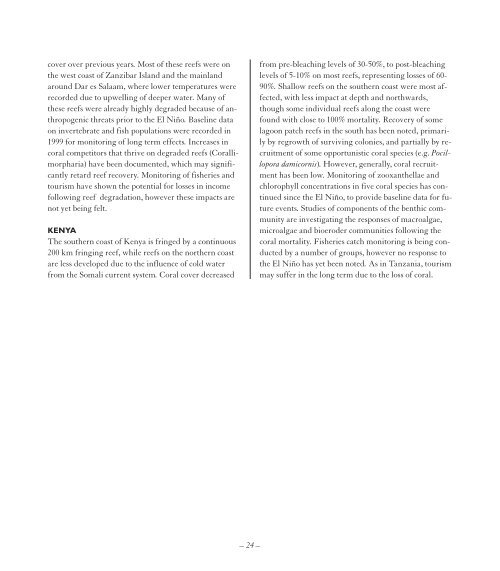You also want an ePaper? Increase the reach of your titles
YUMPU automatically turns print PDFs into web optimized ePapers that Google loves.
cover over previous years. Most of these reefs were on<br />
the west coast of Zanzibar Island and the mainland<br />
around Dar es Salaam, where lower temperatures were<br />
recorded due to upwelling of deeper water. Many of<br />
these reefs were already highly degraded because of anthropogenic<br />
threats prior to the El Niño. Baseline data<br />
on invertebrate and fish populations were recorded in<br />
1999 for monitoring of long term effects. Increases in<br />
coral competitors that thrive on degraded reefs (Corallimorpharia)<br />
have been documented, which may significantly<br />
retard reef recovery. Monitoring of fisheries and<br />
tourism have shown the potential for losses in income<br />
following reef degradation, however these impacts are<br />
not yet being felt.<br />
KENYA<br />
The southern coast of Kenya is fringed by a continuous<br />
200 km fringing reef, while reefs on the northern coast<br />
are less developed due to the influence of cold water<br />
from the Somali current system. Coral cover decreased<br />
from pre-bleaching levels of 30-50%, to post-bleaching<br />
levels of 5-10% on most reefs, representing losses of 60-<br />
90%. Shallow reefs on the southern coast were most affected,<br />
with less impact at depth and northwards,<br />
though some individual reefs along the coast were<br />
found with close to 100% mortality. Recovery of some<br />
lagoon patch reefs in the south has been noted, primarily<br />
by regrowth of surviving colonies, and partially by recruitment<br />
of some opportunistic coral species (e.g. Pocillopora<br />
damicornis). However, generally, coral recruitment<br />
has been low. Monitoring of zooxanthellae and<br />
chlorophyll concentrations in five coral species has continued<br />
since the El Niño, to provide baseline data for future<br />
events. Studies of components of the benthic community<br />
are investigating the responses of macroalgae,<br />
microalgae and bioeroder communities following the<br />
coral mortality. Fisheries catch monitoring is being conducted<br />
by a number of groups, however no response to<br />
the El Niño has yet been noted. As in Tanzania, tourism<br />
may suffer in the long term due to the loss of coral.<br />
– 24 –


















